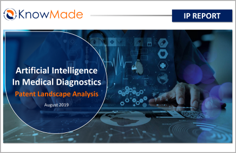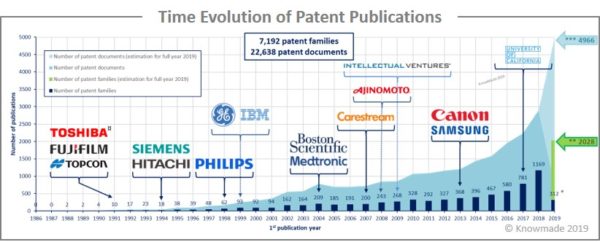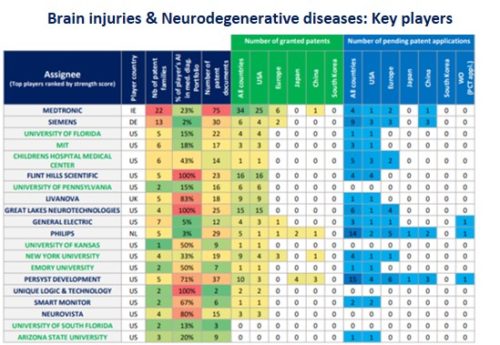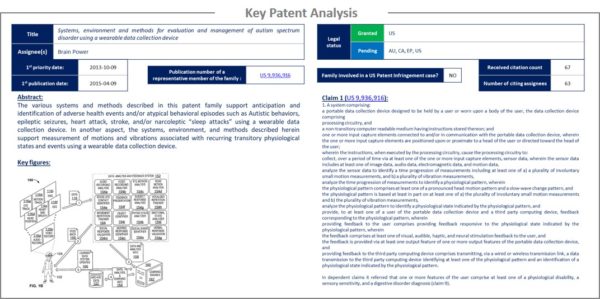
Artificial intelligence is revolutionizing the healthcare industry. What are the most-targeted medical applications, and which companies are going for them?
Publication August 2019
| Download Flyer | Download Sample |
Report’s Key Features

- PDF >170 slides
- Excel file >22,600 patents
- IP trends, including time-evolution of published patents, and countries of patent filings
- Ranking of main patent assignees
- Identifications of over 90 start-up firms and IP newcomers
- Summary of the IP related to the medical exams: ECG, EEG, EMG, MRI, CT scan, PET scan, facial analysis, speech analysis, OCT, etc.
- Summary of the IP related to the clinical areas involved: Cardiology, Oncology, Diabetes, Osteology, etc.
- Key patents & main litigations analysis
- Excel database containing all patents analyzed in this report, including technology and application segmentations
Other KnowMade work: Life sciences patent landscapes.
Patent landscape work is one of the different analyses we produce at KnowMade.
Artificial intelligence is revolutionizing the medical diagnostics industry thanks to its new learning capabilities
With the development of deep learning and neural networks, artificial intelligence (AI) has gained learning capabilities. The result is that some new AIs can now recognize patterns better than human eyes. It paves the way for the emergence of a new generation of medical diagnostic devices capable of surpassing the detection skills of the best medical practitioners. Because artificial intelligence can be replicated, the expertise of these systems can become accessible to a large number of patients. Moreover, AI has numerous and diverse applications in medical diagnostics, such as image analysis for tumor detection, video detection for gait disorders and fall prediction, biochemical tests such as for diabetes or speech analysis of emotional state and psychiatric disorders. Therefore, AI will considerably disrupt the traditional model of medical diagnosis.
According to Yole Développement, more than US$1.1 billion has been invested since 2016 by companies working on the development of artificial intelligence for medical imaging. Companies such as Heartflow received US$340 million investment in the past 5 years. The main expected players in this market are the medical diagnostic systems manufacturers like. General Electric, Philips and Siemens, but also artificial intelligence-guru companies like IBM or Microsoft. Beside these big companies, the number of Intellectual Property (IP) newcomers is important and growing. Unlike the development of new medial devices, artificial intelligence software development costs are moderate. As a result, the number of IP newcomers developing innovative software is likely to continue to rise sharply in coming years. Thereby, with emergence of many new companies like Aidence, Bay Labs and doc.ai, and given the many advantages and new applications of AI for medical diagnostics, it is crucial to understand the intellectual property (IP) position and strategy of these different players. Such knowledge can help detect business risks and opportunities, anticipate emerging applications, and enable strategic decisions to strengthen one’s market position.

The analysis of the time evolution of patent publications shows that the development of medical diagnostic systems with built-in computer-assisted detection features is not new. The first patents related to this topic were published in the 1980s. In the 1990s Japanese medical imaging system manufacturers like Toshiba, Fujifilm, Topcon, Fujitsu and Hitachi started to invest investigate this topic soon followed by European companies like Siemens and Philips and then by American companies like IBM, Medtronic and General Electric. The number of patent families published each year increased progressively until 2015. Since then it has rapidly increased, and now we see the publication of more than 1,100 new patent families in 2018. This shows that AI in medical diagnostics is a very hot topic that is mobilizing great R&D efforts from different players. The main patent assignee in the field of this study is Siemens, with more than 500 patent families. It is followed by Philips and General Electric, with more than 150 patent families each. Most main patent assignees have developed an international IP strategy. Europe-based corporations are showing the widest geographical protection for their inventions. American players mainly protect their inventions in the US and to a lesser extent in Europe and in Asian countries.
Identifying the companies that have recently emerged in the IP landscape
Among the players that have filed patents about AI in medical diagnostics, over 90 newcomers were identified. Many of these companies are startup firms currently developing their first products. These products consist of software solutions such as software for ultrasound imaging analysis, image resolution improvement or real-time brain monitoring, or medical devices capable of live analysis of biological parameters such as blood glucose monitoring apparatus, sleep monitoring sensors and ECG. Numerous IP newcomers are based in the US while some are based in Israel, in Europe or in Asia. It is possible that one of these innovative companies could become one of the next healthcare ‘unicorns’ that the big corporations will be tempted to acquire.
Analysis by segments
 AI applications in medical diagnostics were investigated and the selected patent families were labeled according to the applications to which they relate. Two main categories of applications were investigated, and for each segments (over 40), the patent publication timeline and the patent portfolios of main players were analyzed.
AI applications in medical diagnostics were investigated and the selected patent families were labeled according to the applications to which they relate. Two main categories of applications were investigated, and for each segments (over 40), the patent publication timeline and the patent portfolios of main players were analyzed.
1/ Medical examination modalities including:
Biochemical tests, Blood pressure, Cardiopulmonary sounds, Computed tomography (CT) scanners, Elastography, Electrocardiogram, Electroencephalogram, Electromyogram, Facial analysis, Magnetic Resonance Imaging, Minimally invasive imaging, Movement analysis, Optical Coherence Tomography (OCT) imaging, Photoacoustic imaging, Positron-Emitting Tomography (PET) scanners, Speech analysis, Ultrasound imaging, X-rays.
2/ Medical specialties including:
Allergies, Anesthesia monitoring, Arthropathology & Osteopathology, Brain injuries & neurodegenerative diseases, Cardiology & angiology, Diabetes diagnosis, Gait disorders & Fall prediction, Hepatology, Infectiology, Irritable bowel syndrome & Inflammatory Bowel Disease, Ophtalmology, Pneumopathology, Pregnancy-related & Fetal conditions, Psychiatry & Psychology, Sleep disorders, Stomatology, Oncology and its subsegments.
Key patents analysis
This IP study includes selection and description of key patents. The key patent analysis includes the legal state of the family for each of the main territories, the number of received citations, the review of the main claim(s), the description of interesting features about the innovation discloses and relevant figures illustrating how the innovation works. The description also contains information about a patent family that was involved in patent litigation in the USA.
Companies mentioned in this report (non-exhaustive list)
ABBOTT, AJINOMOTO, ALIPH, ALPHABET, BAUSCH HEALTH, BERG PHARMA, BIOMERIEUX, BOSTON SCIENTIFIC, BRACCO, CANON, CARESTREAM HEALTH, CARIS LIFE SCIENCES, CARL ZEISS, COGNOA, DEXCOM, FACENSE, FUJIFILM, FUJITSU, GENERAL ELECTRIC, HEARTFLOW, HITACHI, HOLOGIC, IBM, IMAGING THERAPEUTICS, JOHNSON & JOHNSON, KONICA, MEDTRONIC, MYSKIN, NESTLÉ, OLYMPUS, PHILIPS, RESMED, ROCHE, SAMSUNG, SENSYS MEDICAL, SIEMENS, TOPCON, VERACYTE, VERMILLION, ZOLL MEDICAL
